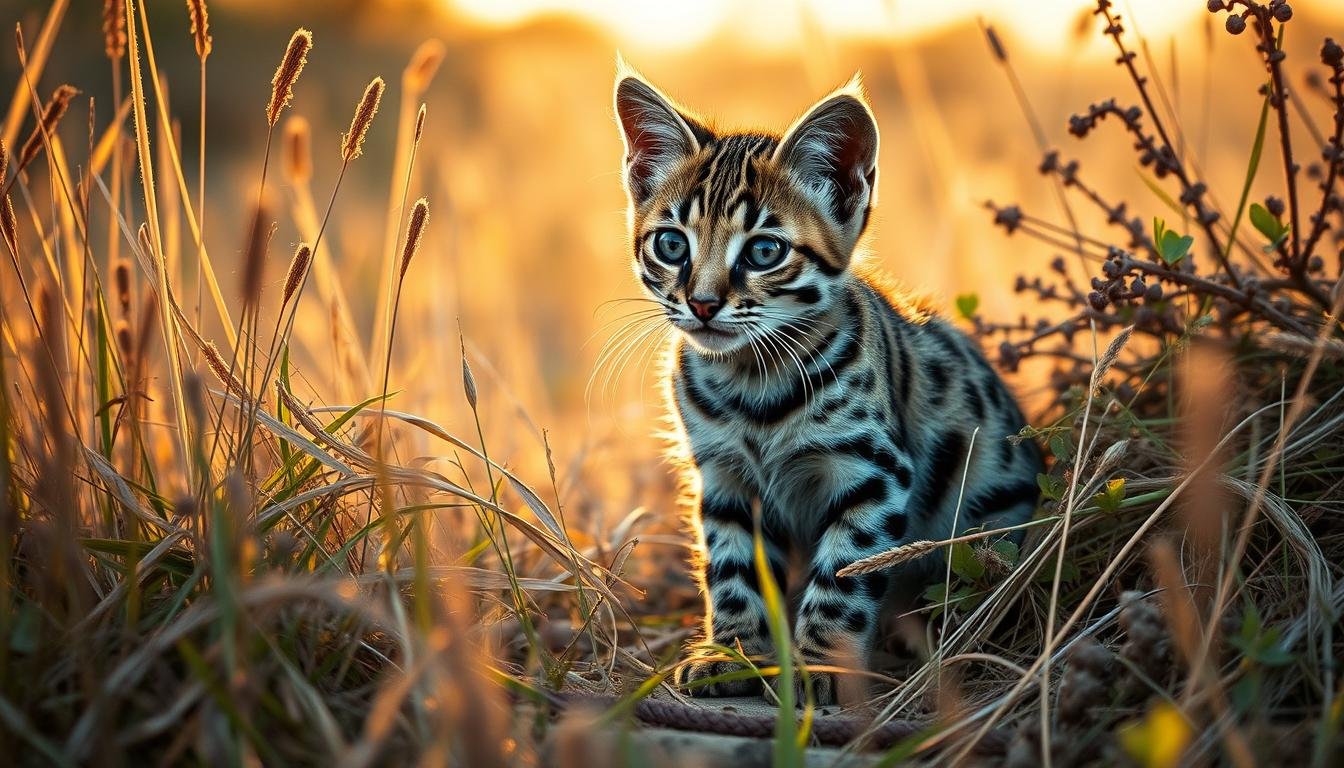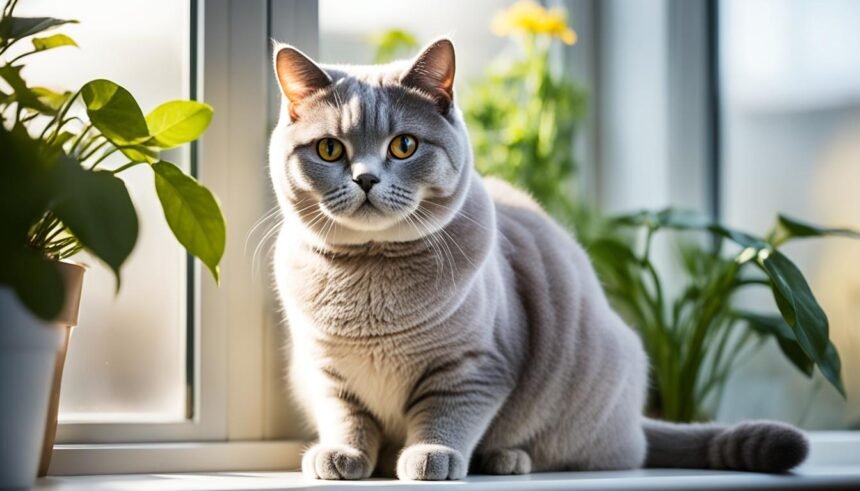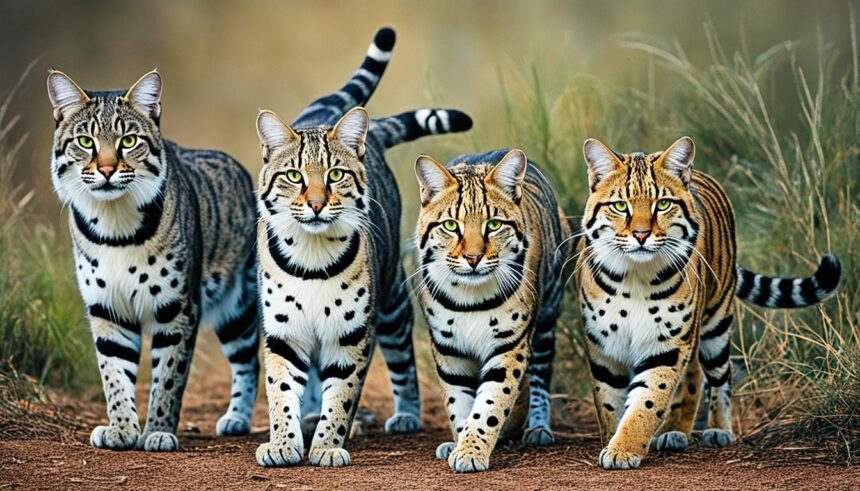The black-footed cat, or Felis nigripes, is a tiny desert feline. It thrives in Southern Africa’s arid landscapes. This nocturnal predator packs a punch despite its small size.
This miniature powerhouse weighs only 2-5 pounds and measures 14-20 inches long. It’s the second smallest wild cat globally, after the rusty-spotted cat. The black-footed cat roams South Africa, Namibia, and Botswana’s semi-arid habitats.
Don’t underestimate this petite predator. It boasts the highest successful kill rate of any feline. The cat can travel up to 10 miles nightly, hunting every 30-50 minutes.
Its hunting efficiency is remarkable. In one night, it can catch more prey than a leopard in six months.
Unfortunately, this species faces major challenges. Only about 10,000 individuals remain in the wild as of 2019. The IUCN Red List classifies it as vulnerable.
Human encroachment and deforestation threaten its survival. Conservation efforts are crucial to protect this unique cat’s future.
Introduction to the Black-Footed Cat
Africa’s smallest wild feline, the black-footed cat, is a captivating creature. This tiny predator belongs to the Felis genus. It’s a unique member of the cat family, sparking interest among wildlife lovers.
Overview of Africa’s Smallest Wild Cat
The black-footed cat is incredibly small. Female adults weigh 1.1 to 1.65 kg, while males reach 1.6 to 2.45 kg. Their body length is 36 to 52 cm, with a tail adding 12 to 20 cm.
Despite their size, these cats are skilled hunters. They eat about 3,000 rodents each year, making them fierce predators.
Scientific Classification and Taxonomy
Felis nigripes, the black-footed cat’s scientific name, split from other Felis species long ago. It’s the only species in its lineage, with no known subspecies.
These cats have adapted well to their environment. They rest in abandoned springhare burrows 98% of the time.
Conservation Status
Since 2002, the black-footed cat has been listed as vulnerable. The IUCN classifies it as Vulnerable, and it’s in CITES Appendix I. Their population is shrinking due to habitat loss and human activities.
Conservation efforts are underway to protect this unique feline. Captive breeding programs, like the one at Wuppertal Zoo in Germany, aim to help.
| Characteristic | Data |
|---|---|
| Conservation Status | Vulnerable (IUCN 3.1) |
| Distribution | Southern Africa |
| Average Weight (Female) | 1.1–1.65 kg |
| Average Weight (Male) | 1.6–2.45 kg |
| Body Length | 36-52 cm |
Physical Characteristics of the Black-Footed Cat
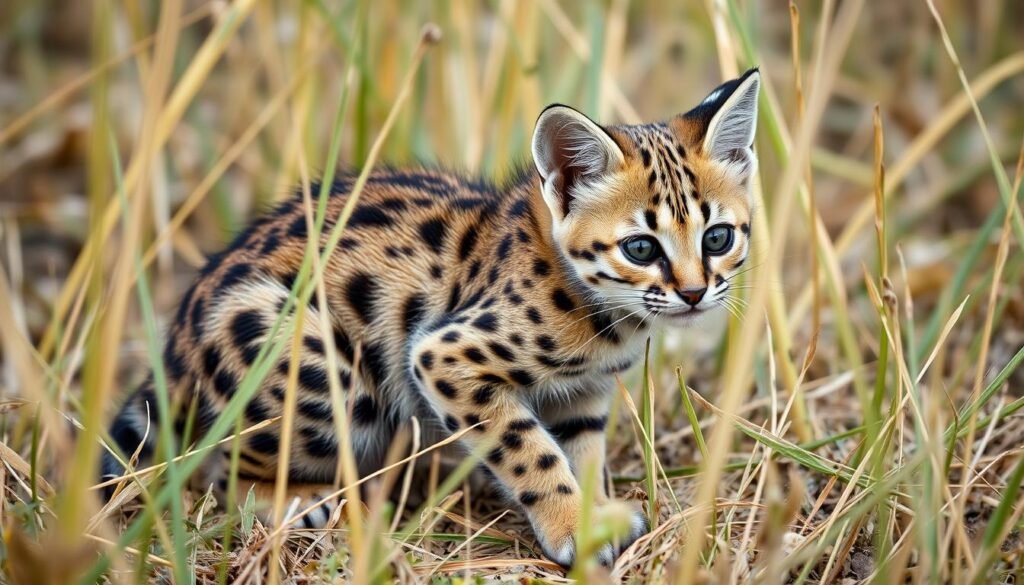
The Black-Footed Cat thrives in southern Africa’s arid regions. This small wild cat has unique features suited for harsh desert environments.
Size and Weight
The Black-Footed Cat is one of the world’s smallest wild cats. Adults weigh between 2.4 to 4.2 pounds, with males being larger. Their body length is 14 to 20 inches, plus a 5 to 8-inch tail.
Distinctive Coat Pattern and Coloration
The cat’s tawny fur offers great camouflage in its desert home. Its color ranges from reddish-fawn in the south to paler shades up north.
Black spots decorate the coat, sometimes forming stripes on the legs. This pattern helps the cat blend in with its surroundings.
Unique Adaptations for Desert Life
These cats have special features for desert survival. Large, rounded ears boost their hearing, vital for finding prey in open areas.
Thick hair covers their foot pads, shielding them from hot desert sands. Their eyes, light green to dark yellow, have vertical-slit pupils for night hunting.
These traits make Black-Footed Cats perfect for life in southern Africa’s tough desert landscape.
Habitat and Distribution
The Black-footed Cat thrives in Southern Africa’s arid savannas and semi-desert areas. Its range covers Botswana, Namibia, and South Africa. There are possible sightings in southern Angola and Zimbabwe too.
These cats prefer open landscapes with short grasses and sparse shrub cover. The Karoo region and Kalahari Desert parts offer ideal living conditions. They can be found at elevations up to 2,000 meters in the Drakensberg area.
Rainfall shapes their habitat significantly. These cats flourish in areas with 100 to 500 millimeters of annual precipitation. Their low moisture needs help them survive in tough conditions.
| Country | Habitat Type | Elevation Range |
|---|---|---|
| Botswana | Arid savanna, Kalahari Desert fringes | 900 – 1,300 m |
| Namibia | Semi-arid shrubland, grasslands | 1,000 – 1,800 m |
| South Africa | Karoo, open grasslands | Sea level – 2,000 m |
Black-footed Cats cover 4.5 to 16 kilometers nightly while hunting for food. This wide-ranging behavior helps them survive in sparse habitats. Their adaptability showcases the resilience of Africa’s smallest wild cat.
The Black-Footed Cat’s Hunting Prowess
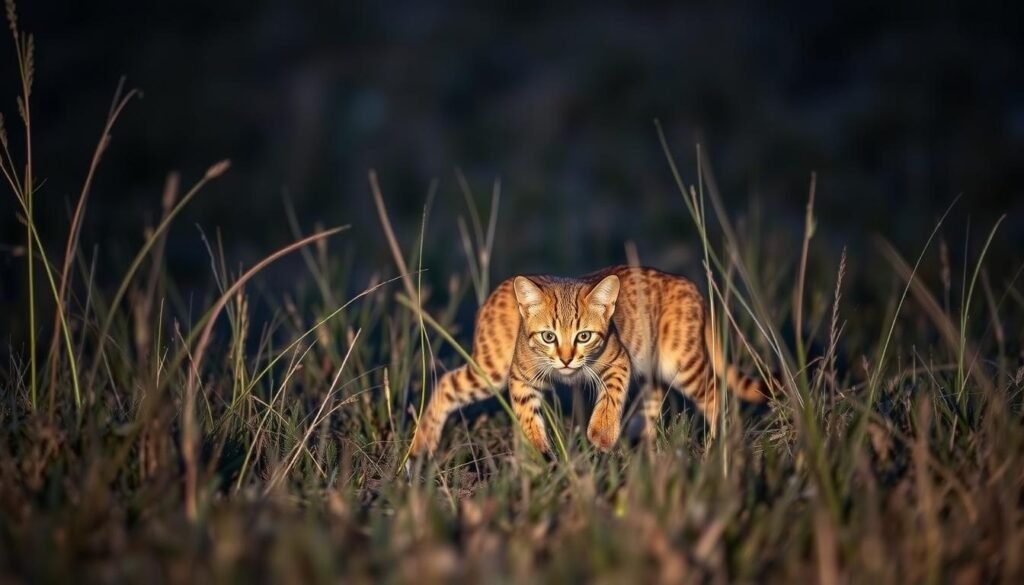
The black-footed cat is a top-notch night hunter in Africa. This small cat outshines many bigger felines with its impressive hunting skills. It’s known for its high success rate in catching prey.
Hunting Techniques
Black-footed cats use three main hunting methods: fast hunting, still hunting, and slow stalking. They can jump up to five feet high and 6½ feet across.
This amazing ability helps them catch both ground and flying prey. Their agility makes them fierce hunters in the wild.
Prey Selection and Consumption
The black-footed cat eats mostly small animals. About half of its diet is insects. The rest includes rodents, birds, and other tiny creatures.
These cats are super efficient hunters. In one night, they can catch up to 14 small prey items.
Comparison with Other Predators
Black-footed cats are the best hunters among felines. They have a 60% success rate, which is twelve times better than tigers.
This high success rate makes them top nocturnal hunters in Africa. They outperform many larger predators in catching prey.
| Species | Hunting Success Rate | Prey Caught per Night |
|---|---|---|
| Black-Footed Cat | 60% | 12-14 |
| Lion | 20% | 1-2 |
| Tiger | 5% | 1-2 |
These small cats are incredibly fierce. They’ve been seen fighting off adult jackals eight times their size. This shows how tough and capable they are as hunters.
Behavioral Traits and Daily Activities
Africa’s smallest wild feline, the black-footed cat, leads a fascinating nocturnal life. These solitary creatures emerge at sunset for nightly hunts. Their vision is six times sharper than humans, making them formidable nighttime predators.
By day, these cats hide in abandoned termite mounds or burrows. These shelters protect them from the desert sun and potential threats. They often use homes made by springhares, aardvarks, or porcupines.
Black-footed cats show incredible stamina during their nightly hunts. They can travel up to 35 km in one night searching for food. Their hunting success rate is an impressive 60%, the highest among wild cats.
These nocturnal hunters eat about 250 grams of prey each night. This amount is roughly one-sixth of their body weight. Despite their small size, they’re skilled and efficient hunters.
Black-footed cats are fiercely independent and maintain large territories. Males roam about 22 square kilometers annually. Females patrol smaller areas of around 10 square kilometers.
These cats only come together during mating seasons. Their solitary nature extends to most of their social interactions.
- Primarily active at night
- Rest in burrows during the day
- Travel long distances for hunting
- Highly successful predators
- Maintain large, solitary territories
Reproduction and Life Cycle
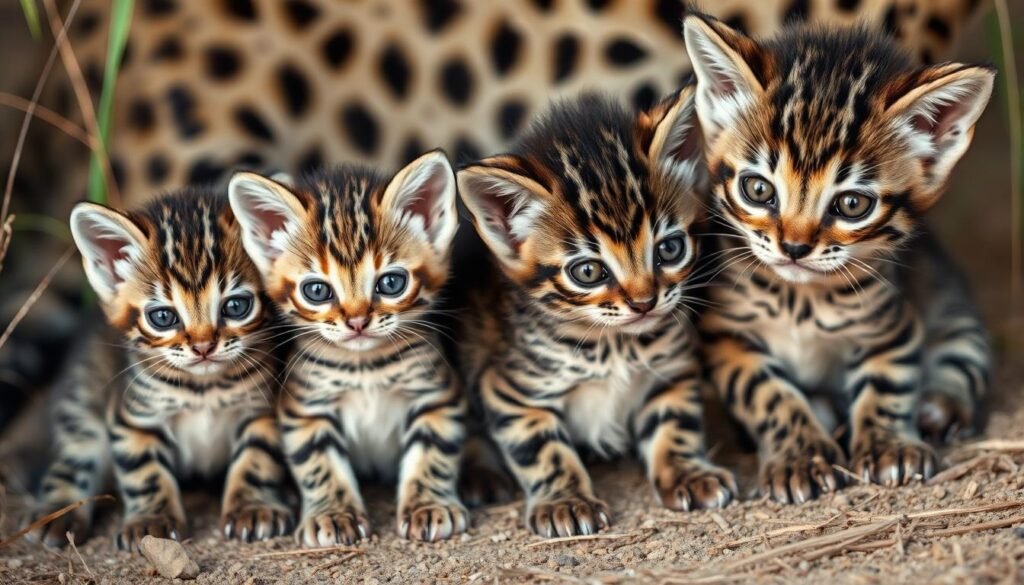
Black-footed cats have special breeding habits. They adapt to tough environments through their mating ways. Their kittens grow fast to survive in harsh conditions.
Mating Habits
Female black-footed cats can have babies at about 15 months old. They might have two litters a year, usually in spring, summer, or fall. Pregnancy lasts 63-68 days, and they have 1-4 kittens each time.
On average, a litter has about 2 kittens. This helps the species keep its numbers up in the wild.
Kitten Development and Care
Newborn kittens weigh between 60-84 grams. They open their eyes around 7 days old. Mothers often move their dens to keep kittens safe from danger.
Kittens become independent at 3-4 months but may stay near mom longer. They start hunting young, learning to survive in their tough home.
Lifespan in the Wild and Captivity
In the wild, black-footed cats live up to 13 years. Their average lifespan is 12 years. Cats in zoos can live longer, up to 16 years.
Longer lives in zoos help with breeding programs. This aids in saving the species from dying out.
| Aspect | Detail |
|---|---|
| Sexual Maturity (Female) | 14.8 months |
| Litters per Year | Up to 2 |
| Gestation Period | 63-68 days |
| Average Litter Size | 1.71 kittens |
| Kitten Independence | 3-4 months |
| Wild Lifespan | Up to 13 years |
| Captive Lifespan | Up to 16 years |
Ecological Role in African Ecosystems
The Black-footed Cat is crucial in African ecosystems. This small predator thrives in southern Africa’s arid regions. Despite weighing only 1.5 to 2.5 kilograms, it greatly impacts its environment.
Black-footed Cats are excellent at rodent control. A single cat can eat up to 3,000 rodents yearly. This helps maintain the balance of small mammal populations in their habitat.
Their diet also includes birds, insects, and reptiles. This shows their adaptability as predators in their ecosystem.
Researchers found 0.17 adult cats per square kilometer in a 60 square kilometer area. This density allows them to coexist with other small carnivores like African wildcats and Cape foxes.
Each species uses different hunting strategies and prey selections. This reduces competition and promotes biodiversity in the region.
| Prey Type | Percentage in Diet | Impact on Ecosystem |
|---|---|---|
| Small Mammals | 72% | Population control, prevents overgrazing |
| Birds | 26% | Influences bird population dynamics |
| Insects and Reptiles | 2% | Contributes to insect and reptile regulation |
The Black-footed Cat’s role as a mesopredator is vital for ecosystem health. They control small prey populations, affecting vegetation patterns and nutrient cycling. This helps maintain balance in southern Africa’s harsh, arid landscapes.
Threats to the Black-Footed Cat Population
Africa’s smallest wild feline, the black-footed cat, faces major challenges. These tiny predators, weighing 1-2.5 kg, battle against human-induced threats. Their population is declining due to these issues.
Habitat Loss and Degradation
Overgrazing by livestock greatly affects black-footed cats. Their habitat in South Africa, Namibia, and Botswana is shrinking. Agricultural expansion forces cats to travel farther for food.
Male cats now cover up to 21.3 km², while females cover 10 km². This increased range puts them at greater risk.
Human-Wildlife Conflict
Poisoning is a severe threat to black-footed cats. Farmers use poison for pest control, harming these small predators. Predator control measures also impact the cats.
Domestic dogs used in these operations sometimes kill cats. They often mistake the small felines for pests.
Climate Change Impacts
Climate change is altering the cats’ habitat. This may reduce suitable areas for their survival. The cats might need to adapt quickly or face further decline.
Shifting climate patterns could disrupt the cats’ mating period. They typically mate between late July and March.
Conservation efforts are vital to protect this unique species. Researchers like Dr. Alex Sliwa have studied these cats since 1992. They use various capture methods to gather data.
Understanding the cats’ behavior is key to protecting them. This knowledge helps develop strategies against overgrazing, poisoning, and predator control.
Conservation Efforts and Challenges
The black-footed cat’s population is dwindling, with fewer than 14,000 left in the wild. This vulnerable species needs urgent protection. Conservationists use various strategies to safeguard these tiny felines.
Captive breeding programs are crucial for preserving the species. Zoos like Wuppertal in Germany lead these efforts to maintain genetic diversity. Radio collar studies provide insights into the cats’ behavior and habitat needs.
These studies show that black-footed cats have a 40 square kilometer home range. They use an average of 11 burrows. Habitat protection is vital for the cats’ survival.
Conservation efforts focus on preserving springhare habitats, a key prey species. This approach benefits both the cats and their ecosystem. Human-wildlife conflict poses challenges to conservation efforts.
Sheep farmers inadvertently impact cat populations by killing jackals, a potential predator. This disrupts the natural balance in the ecosystem.
| Conservation Aspect | Details |
|---|---|
| Population Status | Less than 14,000 in wild |
| Conservation Status | Vulnerable, declining trend |
| Key Study Site | Grunau, Namibia (70,000 hectares) |
| Home Range | Approximately 40 square kilometers |
| Burrow Usage | Average of 11 burrows |
Ongoing research in Namibia and Botswana is crucial for developing effective conservation strategies. These efforts aim to ensure the survival of Africa’s smallest wild cat. The goal is to protect this unique species for future generations.
The Black Footed Cat in Popular Culture and Folklore
The black-footed cat has made a big impact in African folklore and modern media. This tiny feline is known as the “miershooptier” or anthill tiger in South Africa. It has captured the imagination of local communities and wildlife fans.
Local Legends and Myths
In San folklore, the black-footed cat is praised for its bravery. A popular legend claims this small predator can take down a giraffe. This tale is clearly exaggerated but shows the respect these tiny hunters command.
Representation in Media and Literature
The black-footed cat has gained fame through wildlife documentaries. These shows highlight its amazing hunting skills. PBS Nature’s “Super Cats” series featured this small feline, showcasing its desert adaptations.
These portrayals have raised awareness about this lesser-known species. They’ve also highlighted its conservation needs. The black-footed cat reminds us of Africa’s rich biodiversity.
This small but mighty hunter appears in traditional stories and modern media. It continues to captivate people worldwide about nature’s wonders. Its growing popularity educates many about the importance of preserving unique species.
FAQ
What is the scientific name of the black-footed cat?
The black-footed cat’s scientific name is Felis nigripes.
Where is the black-footed cat found?
The black-footed cat lives in Southern Africa. It’s found in South Africa, Botswana, and Namibia. The cat may also live in southern Angola and Zimbabwe.
What is the conservation status of the black-footed cat?
The IUCN Red List classifies the black-footed cat as Vulnerable. This status has been in place since 2002. The cat’s population is thought to be declining due to various threats.
What are the unique physical adaptations of the black-footed cat?
The black-footed cat has large, rounded ears for better hearing. Its foot pads are covered in hair to protect against hot sand. The cat’s eyes have vertical-slit pupils.
Its tawny fur is covered in black spots or stripes.
What kind of habitat does the black-footed cat prefer?
The black-footed cat lives in open, arid savannas and semi-arid shrubland. It prefers areas with short grasses and low bush cover. These areas typically receive 100-500 mm of annual rainfall.
How does the black-footed cat hunt?
The black-footed cat uses three main hunting techniques: fast hunting, still hunting, and slow stalking. It has an impressive 60% hunting success rate, higher than lions. The cat can jump up to 2 meters to catch flying birds.
What is the black-footed cat’s role in African ecosystems?
The black-footed cat helps control rodent populations in Southern Africa’s arid regions. One cat can eat up to 3,000 rodents each year. This helps maintain balance in the ecosystem.
What are the major threats to the black-footed cat population?
Major threats include habitat loss from overgrazing and indirect poisoning from pest control. Domestic dogs also kill these cats during predator control operations. Climate change may pose additional risks.
What conservation efforts are being made for the black-footed cat?
Conservation efforts include long-term studies using radio telemetry and captive breeding programs. Habitat protection initiatives are also underway. Researchers face challenges studying this elusive species. Knowledge of its distribution in some areas is limited.
How is the black-footed cat represented in popular culture and folklore?
In parts of South Africa, the black-footed cat is called “miershooptier” (anthill tiger). San legends feature this remarkable hunter. Wildlife documentaries showcase its desert life adaptations and hunting skills.

